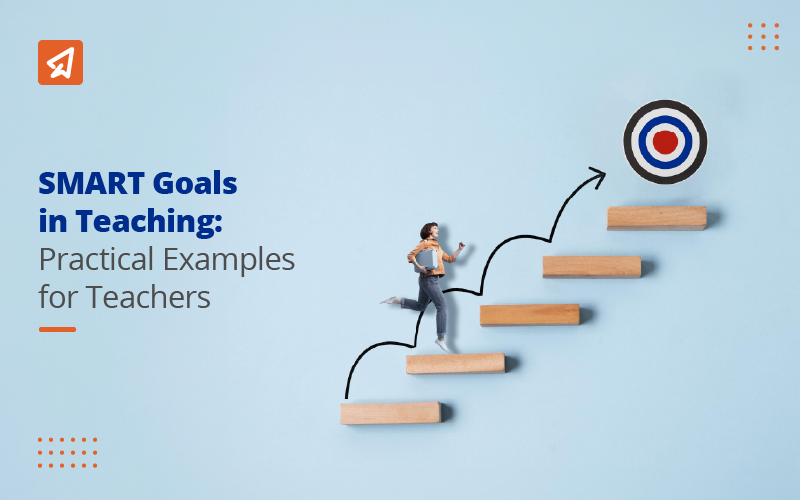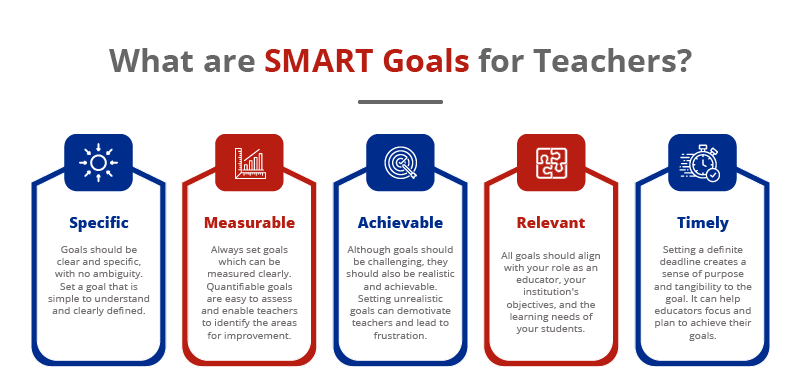SMART Goals in Teaching: Practical Examples for Teachers

Professional development is essential for job satisfaction in every field. Teachers should also be mindful of their professional development and look for new ways to grow their skills and pedagogical strategies. Setting measurable and strategic goals is the best place to start professional development.
Some educators may procrastinate in setting goals or may find it difficult to spend time setting them. It could be due to busy schedules, past experiences, lack of motivation, or they may be unsure how to measure their goals. Extramarks’ SMART goal-setting rubric is designed to help teachers set realistic, strategic, measurable, and attainable goals for professional development. Our well-researched program takes general, broad aspirations and turns them into specific goals that contribute to your long-term career plans.
What are SMART Goals for Teachers?

- Specific – Goals should be clear and specific, with no ambiguity. Set a goal that is simple to understand and clearly defined.
- Measurable – Always set goals which can be measured clearly. Quantifiable goals are easy to assess and enable teachers to identify the areas for improvement.
- Achievable – Although goals should be challenging, they should also be realistic and achievable. Setting unrealistic goals can demotivate teachers and lead to frustration.
- Relevant – All goals should align with your role as an educator, your institution’s objectives, and the learning needs of your students.
- Timely – Setting a definite deadline creates a sense of purpose and tangibility to the goal. It can help educators focus and plan to achieve their goals.

Why is it Important for Teachers to Set SMART Goals?
SMART goals can be helpful for every professional to empower their career growth. However, SMART goals are particularly important for teachers and educators. Here is why –
- Enhanced Teacher Effectiveness – Professional development goals that help teachers improve their pedagogy, delivery, and classroom management techniques – are essential for enhancing teaching effectiveness.
- Promoting Professional Development – Working towards SMART goals can help teachers prioritise their professional development efforts. To attain the SMART goals, educators must explore new instruction methods, understand new learning styles, and refine their teaching skills.
- Boosting Student Performance – As teachers strive to achieve SMART goals, they employ better instructional methods and improve their teaching skills. These efforts can positively influence students’ understanding, engagement and performance.
- Accountable – Setting SMART goals ensures that the goals are quantifiable and measurable. It offers tangible proof of progress and completion of every goal. The measurability of SMART goals promotes accountability among teachers.
- Developing a Growth Mindset – Setting SMART goals and working towards achieving them helps foster a growth mindset among educators. It also sets a good example for students to achieve their goals systematically.
How to Create SMART Goals for Teachers?
Creating SMART goals is about asking the right questions. Whenever you consider setting a goal for your education career, ask yourself the following questions –
- Strategic – What are you trying to achieve?
- Measurable – How will you determine that you have achieved your goal?
- Achievable – Is your goal realistic and achievable with the resources you have?
- Relevant – How does the goal fit into your role as an educator?
- Time Bound – Have you defined a deadline for your goal?
Sample SMART Goals for Teachers
Classroom Management
Make a habit of updating essential information such as homework, critical questions, and lessons completed on the class board. Keep up this practice till the end of the school year.
- Building a new system of classroom rules for behaviour and attitude management. Finding ways to inspire at least 90% of students in the class to comply with the regulations by the end of the month.
- Document classroom disruptions in a daily class log and find ways to reduce them by 30% by the end of the quarter.
- Design effective classroom management strategies to improve time management and reduce off-task time by 20% this academic year.
- Improve classroom tidiness and organisation to ensure less than 1 lost property case per week by the end of the third semester.
Student Engagement
- Experiment with one new activity, such as group discussions, think-pair-share, and other interactive sessions to promote student engagement.
- Define an incentive system for the students that recognises and celebrates students’ progress and fosters a positive learning environment for all the students.
- Add group projects and cooperative learning activities in every lesson plan to enable students to work together and develop better social skills.
- Include better educational technology tools in lessons to improve student participation and engagement, such as interactive presentations, online simulations, and augmented reality.
- Integrate real-life examples, case studies, and current events to build relatability of the concepts. It will also help students understand the practical application of the subject matter.
Professional Development
- Find and attend at least one professional development workshop or conference per month to increase my pedagogical skills by 20%
- Complete at least one certification in a new teaching methodology or instructional strategy by the end of the school year.
- Create a personalised professional development plan through self-reflection and identifying areas of improvement. Implement at least two strategies from the plan per semester.
- Read professional teaching journals and implement strategies from them every month.
- Score at the proficient or outstanding levels in the next performance evaluation.
- Author or co-author and publish a research paper on innovative teaching methods this academic year.
Technology Integration
- Successfully integrate new education technology to make classrooms smart to increase student engagement by 25% and measure the impact through pre- and post-assessment.
- Learn more about education technology by attending at least two edtech-focused professional development workshops and applying the new skills to the classroom.
- Create a new tech-based project or activity in partnership with colleagues to promote critical thinking and problem-solving skills among students and achieve at least 80% student satisfaction in the survey.
- Incorporate the 360-degree teaching solution by Extramarks to facilitate live sessions, homework, test creation and online class management across classes.
- Increase the usage of educational apps among students by 50% by the end of this academic year.

Parent-Teacher Communication
- Increase parent engagement and satisfaction by 20% based on feedback surveys by establishing new communication channels, including newsletters, email updates, and parent-teacher conferences.
- Implement new strategies to involve parents in their child’s learning journey. Organise at least one parent learning workshop on relevant topics to support learning at home.
- Seek regular feedback from parents using surveys and informal conversations, try to understand their perspective and introduce new initiatives or changes based on parent feedback every quarter.
- Organise two class events per year where parents are encouraged to participate.
Teacher Well-Being
- Implement a daily practice to improve mindfulness, reduce stress, and promote well-being. Set aside time daily to meditate and use technological products to practice mindfulness and enhance well-being.
- Establish a healthy work-life balance by setting boundaries and prioritising self-care. Spend at least two evenings every evening pursuing a hobby or learning something interesting. Aim to maintain a positive work-life balance.
- Work towards better physical health by exercising, eating healthy and reducing stress in daily life. Good physical health can improve overall well-being.
Student Achievement & Learning
- All students in the class should attain a 75% score on the standardised test at the end of the semester – by improving their mathematical skills.
- Improve student performance in English by 15% by changing instructional methodology.
- Increase the number of students achieving grade-level reading proficiency by 10% by the end of the academic year.
- Achieve a 15% improvement in the class’s history project performance score at the year’s end.
Lesson Planning
- Identify students with different learning needs and implement at least one differentiated lesson per unit to accommodate them.
- Incorporate new improvements in instruction methods based on student feedback every month.
- Collaborate with two or more subject teachers to create an interdisciplinary lesson every week.
- Increase the frequency of student progress monitoring by 20% by designing lessons embedded with formative assessments in every unit.
SMART goals help teachers and students achieve higher goals. They help the education system improve existing systems and methodologies by inspiring educators to pursue personal and professional goals. SMART Goals by Extramarks empowers educational institutions by investing in teachers’ professional growth.
Last Updated on February 12, 2025
Reviewed by

Prachi Singh | VP - Academics
Prachi Singh is a highly accomplished educationist with over 16 years of experience in the EdTech industry. Currently, she plays a pivotal role at Extramarks, leading content strategy and curriculum development initiatives that shape the future of education...read more.











